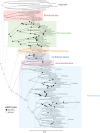Structure, function and parallel evolution of the bivalve byssus, with insights from proteomes and the zebra mussel genome
- PMID: 33813897
- PMCID: PMC8059631
- DOI: 10.1098/rstb.2020.0155
Structure, function and parallel evolution of the bivalve byssus, with insights from proteomes and the zebra mussel genome
Abstract
The byssus is a structure unique to bivalves. Byssal threads composed of many proteins extend like tendons from muscle cells, ending in adhesive pads that attach underwater. Crucial to settlement and metamorphosis, larvae of virtually all species are byssate. By contrast, in adults, the byssus is scattered throughout bivalves, where it has had profound effects on morphological evolution and been key to adaptive radiations of epifaunal species. I compare byssus structure and proteins in blue mussels (Mytilus), by far the best characterized, to zebra mussels (Dreissena polymorpha), in which several byssal proteins have been isolated and sequenced. By mapping the adult byssus onto a recent phylogenomic tree, I confirm its independent evolution in these and other lineages, likely parallelisms with common origins in development. While the byssus is superficially similar in Dreissena and Mytilus, in finer detail it is not, and byssal proteins are dramatically different. I used the chromosome-scale D. polymorpha genome we recently assembled to search for byssal genes and found 37 byssal loci on 10 of the 16 chromosomes. Most byssal genes are in small families, with several amino acid substitutions between paralogs. Byssal proteins of zebra mussels and related quagga mussels (D. rostriformis) are divergent, suggesting rapid evolution typical of proteins with repetitive low complexity domains. Opportunities abound for proteomic and genomic work to further our understanding of this textbook example of a marine natural material. A priority should be invasive bivalves, given the role of byssal attachment in the spread of, and ecological and economic damage caused by zebra mussels, quagga mussels and others. This article is part of the Theo Murphy meeting issue 'Molluscan genomics: broad insights and future directions for a neglected phylum'.
Keywords: Dreissena polymorpha; bivalve genome; byssal threads.
Figures


Similar articles
-
Zebra mussel adhesion: structure of the byssal adhesive apparatus in the freshwater mussel, Dreissena polymorpha.J Struct Biol. 2012 Mar;177(3):613-20. doi: 10.1016/j.jsb.2012.01.011. Epub 2012 Jan 30. J Struct Biol. 2012. PMID: 22309789
-
Gene expression profiling during the byssogenesis of zebra mussel (Dreissena polymorpha).Mol Genet Genomics. 2010 Apr;283(4):327-39. doi: 10.1007/s00438-010-0517-8. Epub 2010 Feb 11. Mol Genet Genomics. 2010. PMID: 20148265
-
Novel proteins identified in the insoluble byssal matrix of the freshwater zebra mussel.Mar Biotechnol (NY). 2014 Apr;16(2):144-55. doi: 10.1007/s10126-013-9537-9. Epub 2013 Sep 24. Mar Biotechnol (NY). 2014. PMID: 24057171
-
The quagga mussel, Dreissena rostriformis: a novel model for EcoEvoDevo, environmental research, and the applied sciences.Front Cell Dev Biol. 2025 Jan 9;12:1531560. doi: 10.3389/fcell.2024.1531560. eCollection 2024. Front Cell Dev Biol. 2025. PMID: 39850802 Free PMC article. Review.
-
What we know and don't know about the invasive zebra (Dreissena polymorpha) and quagga (Dreissena rostriformis bugensis) mussels.Hydrobiologia. 2022 Oct 13:1-74. doi: 10.1007/s10750-022-04950-5. Online ahead of print. Hydrobiologia. 2022. PMID: 36258710 Free PMC article. Review.
Cited by
-
TRPM7-Mediated Ca2+ Regulates Mussel Settlement through the CaMKKβ-AMPK-SGF1 Pathway.Int J Mol Sci. 2023 Mar 11;24(6):5399. doi: 10.3390/ijms24065399. Int J Mol Sci. 2023. PMID: 36982474 Free PMC article.
-
The genome of the zebra mussel, Dreissena polymorpha: a resource for comparative genomics, invasion genetics, and biocontrol.G3 (Bethesda). 2022 Feb 4;12(2):jkab423. doi: 10.1093/g3journal/jkab423. G3 (Bethesda). 2022. PMID: 34897429 Free PMC article.
-
Toward invasive mussel genetic biocontrol: Approaches, challenges, and perspectives.iScience. 2023 Sep 28;26(10):108027. doi: 10.1016/j.isci.2023.108027. eCollection 2023 Oct 20. iScience. 2023. PMID: 37860763 Free PMC article. Review.
-
Invasive mussels fashion silk-like byssus via mechanical processing of massive horizontally acquired coiled coils.Proc Natl Acad Sci U S A. 2023 Nov 28;120(48):e2311901120. doi: 10.1073/pnas.2311901120. Epub 2023 Nov 20. Proc Natl Acad Sci U S A. 2023. PMID: 37983489 Free PMC article.
-
Tracing the evolution of tissue inhibitor of metalloproteinases in Metazoa with the Pteria penguin genome.iScience. 2023 Nov 25;27(1):108579. doi: 10.1016/j.isci.2023.108579. eCollection 2024 Jan 19. iScience. 2023. PMID: 38161420 Free PMC article.
References
-
- Stanley SM. 1972. Functional morphology and evolution of byssally attached bivalve mollusks. J. Paleontol. 46, 165-212.
-
- Yonge CM. 1962. On the primitive significance of the byssus in the Bivalvia and its effects in evolution. J. Mar. Biol. Assoc. UK 42, 113-125.
-
- Cranfield HJ. 1973. Observations on the function of the glands of the foot of the pediveliger of Ostrea edulis during settlement. Mar. Biol. 22, 211-223. (10.1007/bf00389175) - DOI
-
- Owada M. 2007. Functional morphology and phylogeny of the rock-boring bivalves Leiosolenus and Lithophaga (Bivalvia: Mytilidae): a third functional clade. Mar. Biol. 150, 853-860. (10.1007/s00227-006-0409-y) - DOI
Publication types
MeSH terms
Substances
Associated data
LinkOut - more resources
Full Text Sources
Other Literature Sources

